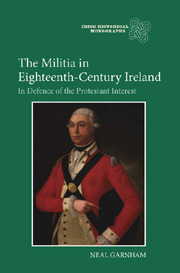Book contents
- Frontmatter
- Contents
- Preface
- Acknowledgments
- Abbreviations
- Introduction: Militia issues
- 1 To 1691: Precursors
- 2 1692–1716: Establishment
- 3 1716–59: Maintenance
- 4 1760: Action
- 5 1761–69: Reform Debated and Attempted
- 6 1769–78: Reform Achieved
- 7 1778–82: Volunteering Ascendant
- 8 1782–85: Fencible Men and the Militia Reconsidered
- 9 1785–93: Indecision and an Act
- 10 Conclusions
- Bibliography
- Index
2 - 1692–1716: Establishment
Published online by Cambridge University Press: 05 February 2013
- Frontmatter
- Contents
- Preface
- Acknowledgments
- Abbreviations
- Introduction: Militia issues
- 1 To 1691: Precursors
- 2 1692–1716: Establishment
- 3 1716–59: Maintenance
- 4 1760: Action
- 5 1761–69: Reform Debated and Attempted
- 6 1769–78: Reform Achieved
- 7 1778–82: Volunteering Ascendant
- 8 1782–85: Fencible Men and the Militia Reconsidered
- 9 1785–93: Indecision and an Act
- 10 Conclusions
- Bibliography
- Index
Summary
Even before the Williamite war had ended proposals were being made for militia reform in Ireland. The fact that the force was ‘only voluntary’ was seen as a distinct disadvantage. Moreover, it was realised that this was an issue in which ‘the king's conjunction with the parliament’ was essential to allow a satisfactory outcome. The force existed only under royal prerogative, being called together by royal proclamation as circumstances demanded. The aim now became to establish in Ireland a militia force that would enjoy a statutory existence and control. A statutory force, while giving parliament a say in its existence, also had the advantage that it could be made to involve compulsory service and that a regular vote of credit could be expected. That process would take almost two and a half decades to complete.
Securing legislation would be complicated not just by political rivalries, but also by the Irish legislative process. In the wake of the Williamite conquest the Irish parliament would become an indispensable part of the Irish governmental system, yet its independence was severely limited by the existence of Poynings' Law. This medieval statute ensured that the Irish parliament could only consider measures already approved in London by the monarch and his council, and that no Irish parliament would sit before a legislative programme had been prepared. In order to circumvent this provision, and in an attempt to control its own agenda, the Irish parliament developed the ‘heads of bills’ procedure.
- Type
- Chapter
- Information
- The Militia in Eighteenth-Century IrelandIn Defence of the Protestant Interest, pp. 14 - 34Publisher: Boydell & BrewerPrint publication year: 2012



